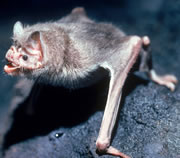
They say an elephant never forgets. But the vampire bat may go one better, in a fittingly chilling way. The bats may not only remember the sound of each victim’s breath, but also make use of that memory to seek out the same animal for future feeds.
The common vampire bat Desmodus rotundus from South America, which feeds exclusively on blood, identifies sounds in the same way that humans use their voices to recognize each other, say researchers.
With cattle blood as a reward, scientists at the Ludwig-Maximilians-Universität in Munich taught three adult bats to associate 10-second clips of human breathing with one of three food dispensers.
The bats recognized sound clips and associated them with their corresponding bottle nearly 100% of the time, beating humans undergoing an equivalent test using touch-screen computers. Unlike the vampire bats, humans were unable to classify breathing sounds that were recorded under physical stress.
“Vampire bats are incredibly intelligent and fast,” says Daniel Riskin, a professor of biomedical sciences at Cornell University, Ithaca, New York, an expert on vampire bats and their behaviour. “You would think that a person would do pretty well at distinguishing sound because we are so smart and good at communicating. However, the bats were better at it.”
The way the bats feed is quite dangerous - to them rather than their prey - since their night-time meal involves slicing open the heels of animals a thousand times bigger than they are. The ability to find an open wound left from the night before could be a useful trick. Also, as the bats favour calves over older cattle, their memory might let them return to a particularly succulent meal.
Some bats eavesdrop on the calls of other bats to cash in on their prey, or even pursue the bats themselves, but no other animal is known to use its aural memory as a hunting tool, say researchers.
While most bats are awkward on the ground, the vampire bat, which has a body about the length of a human thumb, has the agility to run between prey using faculties such as smell, echolocation and infrared sensors on its nose to find in the dark what its big eyes fail to see.
In the wild, vampire bats consume up to 1.4 times their body weight in blood night after night. “They have such a specialized feeding mode; this is a very clear example of vampire bats showing definite signs of being able to discriminate between sounds,” says Riskin.
Bron: news @ nature.com
